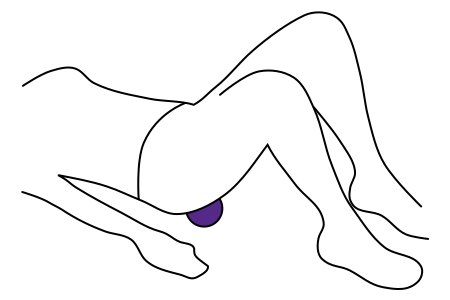What are spiky balls?
Simply put, the spiky ball is a life changer. They are our number one rehabilitation aid, and you’ll find a basket of them at our reception desk.
Whilst prickly and firm on the outside, these tough little nuggets will quickly become your favourite sidekick once you’ve got some simple techniques under your belt.
Spiky balls have become a hugely popular tool for performing self-therapy on many muscle-related conditions and are a convenient way to maximise muscle recovery for athletes and desk workers alike. With the recently increasing numbers of people working from home (thanks COVID), everyone could use a bit more help for those days when you end up bogged down and can’t make it in to see your Osteo.
How do spiky balls perform their magic?
- Spiky balls treat the myo-fascial* system to reduce muscle tension, improve blood flow, increase body awareness and aid in injury prevention and rehabilitation.
- By targeting trigger points, spiky balls can reduce pain levels and improve range of motion through specific muscles and subsequently improve joint motion.
- Spiky balls also help relieve postural tension – when we are glued to our desk all day, the muscles holding ourselves in position (typically rounded shoulders and slumped upper back) become overused, shortened and tight. Releasing these muscles with a spiky ball, can greatly reduce our susceptibility to chronic postural issues and the resulting higher predisposition to many injuries.
*The myo-fascial system refers to the body’s network of muscles and their fascia – the thin sheath (think cling film) that overlies muscles and is a connective pathway between muscles, bones, nerves and blood vessels.
How to use a spiky ball
Spiky balls are essentially your take-home Osteopath – wherever your practitioner successfully uses his/her thumb or elbow to treat your muscles and fascia, this is where the spiky ball can be effective.
Three key elements to a successful spiky ball session:
- You
- The ball
- A hard surface
It’s that easy. Here are some common areas that the spiky ball can treat effectively.
1. Upper Back
A desk worker’s favourite. Standing up, place the spiky ball on the muscles between your shoulder blade and your spine. Press into the wall and use your body weight to roll over the ball in order to find trigger points.
2. Glute
Lie on your back with your knees bent and feet flat on the ground. Place your spiky ball underneath your buttocks and gently roll over the ball until you find a trigger point. To increase the pressure, let the knee on the affected side slowly drop out to the side.
 3. Foot
3. Foot
Place the spiky ball underneath your foot and apply your body weight through the foot and roll the ball from your heel towards your toes. Transfer your body weight forwards to increase the pressure.
Important note: DO NOT USE your spiky ball if you have a recent injury or trauma which has broken the skin, generated swelling, caused inflammation of a joint, or if you are badly bruised. If you start to experience pain that does not subside or increases following use of the spiky ball please do not continue with these exercises until you have spoken with your Osteopath.
Ask about a spiky ball next time you come in for a consultation. We always have them available. If you’d like to speak to our practitioners about incorporating the spiky ball in to your exercise or recovery routine, please feel free to contact us at any time:
- (03) 9939 1289
- info@melbourneosteopathycentre.com.au
- Book a consultation online




 3. Foot
3. Foot